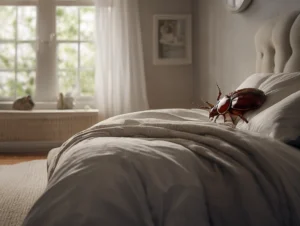Winter in Ontario brings beautiful snowfall, cozy nights indoors — and unfortunately, an annual rise in rodent activity. As temperatures drop, mice, rats, and other small pests look for warmth and shelter, turning homes across the GTA, Peel Region, Halton Region, Hamilton, Kitchener-Waterloo, Cambridge, Guelph, London, Woodstock, Ingersoll, and surrounding Southwestern Ontario communities into prime targets.
If you’re hearing scratching sounds in your walls, tapping noises in the attic, or noticing droppings under the kitchen sink, there’s a good chance you’ve become part of Ontario’s seasonal surge in rodent invasions.
This guide explains why winter rodent infestations happen, the health risks, how to protect your home, and what homeowners across the GTA & Southwestern Ontario should do when signs of activity appear. High-authority government links are included to support public safety and improve your website’s credibility and SEO.
Why Winter is Peak Rodent Season in Ontario
Rodents don’t hibernate. As soon as temperatures fall below freezing, they begin seeking indoor shelter where they can:
- Stay warm
- Find access to food
- Build safe nesting sites
- Hide from predators
Ontario’s Public Health agencies confirm that rodents reproduce year-round indoors, meaning a small winter intrusion can turn into a full infestation within weeks.
Official guidance on rodent-borne disease risks:
Public Health Ontario — Rodent-borne diseases
https://www.publichealthontario.ca/en/diseases-and-conditions/infectious-diseases/vector-borne-zoonotic-diseases/hantavirus
Common Rodents Invading GTA & Southwestern Ontario Homes
House Mice (Most Common)
- Can squeeze through gaps as small as a dime
- Excellent climbers; often heard in attic spaces and wall voids
- Rapid reproduction: 10–12 litters per year
Norway Rats
- Enter basements, garages, crawlspaces, and foundations
- Large body size makes scratching and chewing noises louder
- Known to chew on electrical wiring, risking fires
Roof Rats (Increasing in GTA)
- More common in warmer climates but steadily increasing in cities like Toronto, Mississauga, and Brampton
- Frequently invade attics
- Require different exclusion techniques than Norway rats
Public Health Ontario also provides detailed descriptions of rodents and diseases associated with them:
https://www.publichealthontario.ca/en
Signs of Rodent Activity Inside Your Home
Homeowners usually discover infestations because they hear unusual noises — especially at night.
1. Scratching in walls
Often heard behind kitchen cabinets, bathroom walls, and basement utility rooms.
2. Noises in the attic at night
Rodents are nocturnal, so nighttime activity is usually more noticeable.
3. Droppings
Mouse droppings: small, black, rice-shaped
Rat droppings: larger, blunt ends
4. Chewed food packaging or gnaw marks
5. Grease marks along walls or baseboards
6. Nesting materials
Insulation, paper, cardboard, or shredded fabric.
If you notice any of these, immediate action reduces the risks of property damage and disease.
Cities & Communities in the GTA & Southwestern Ontario Most Affected
This blog focuses only on the regions Vanish Canada Pest Control serves.
Rodent activity is highest in:
Greater Toronto Area & Peel
- Toronto
- Mississauga
- Brampton
Halton & Hamilton Region
- Oakville
- Burlington
- Milton
- Hamilton
- Ancaster
- Stoney Creek
Kitchener–Waterloo–Cambridge–Guelph Corridor
- Kitchener
- Waterloo
- Cambridge
- Guelph
Southwestern Ontario
- London
- St. Thomas
- Woodstock
- Ingersoll
- Tillsonburg
- Stratford
- Brantford
Population density, older homes, urban waste systems, and commercial buildings all contribute to higher rodent pressure in these regions.
Top Health Risks Caused by Rodents
Rodents inside the home aren’t just annoying — they pose real health dangers.
1. Hantavirus
Found in rodent droppings, urine, and saliva. It can become airborne during cleaning.
Ontario guidance:
https://www.ontario.ca/page/animal-health-hantavirus
2. Salmonella
Rodents frequently contaminate food or surfaces.
3. Leptospirosis
Spread through rodent urine, especially in basements or garages.
4. Asthma & breathing issues
Rodent dander and droppings can trigger respiratory reactions.
5. Parasites
Rodents bring mites, fleas, and ticks into homes.
6. Rabies (indirect wildlife interactions)
While rodents rarely carry rabies, homeowners responding to noises sometimes encounter wildlife like bats or raccoons, which can be rabies carriers.
Provincial rabies guidelines:
https://www.publichealthontario.ca/en/diseases-and-conditions/infectious-diseases/vector-borne-zoonotic-diseases/rabies
How Rodents Enter Homes in the GTA & Southwestern Ontario
Most winter infestations happen through small but overlooked gaps around the home.
Typical entry points include:
- Gaps in door frames or weather stripping
- Holes around utility lines
- Cracks in foundation walls
- Damaged soffits, fascia, or roofline
- Dryer-vent openings
- Basement windows
- Garage doors that don’t fully seal
- Openings behind kitchen cabinets
The Ministry of Ontario advises homeowners to secure outdoor structures and seal all potential access points:
https://www.ontario.ca/page/preventing-and-managing-conflicts-small-animals
How to Protect Your Home: A Three-Part Winter Strategy
1. Seal Entry Points (The Most Important Step)
Rodent exclusion requires durable materials, including:
- Steel mesh
- Hardware cloth
- Metal flashing
- Professional-grade sealants
Avoid relying on DIY foam alone — rodents can chew through it in minutes.
For best results, a technician inspects:
- The entire foundation
- Roof edges
- Attic and vent openings
- Garage edges
- Gaps around pipes
- Basement windows
2. Remove Food & Water Sources
Inside:
- Store pantry items in sealed containers
- Clean crumbs and grease immediately
- Keep pet food stored in sealed bins
- Empty trash daily and clean garbage bins regularly
Outside:
- Secure garbage & compost
- Remove birdseed spills
- Store firewood away from the house
- Clean up fallen fruit
- Fix leaky hoses or exterior taps
The City of Toronto provides additional rodent prevention guidelines:
https://www.toronto.ca/city-government/public-notices-bylaws/bylaw-enforcement/property-standards-keep/rodent-control/
3. Monitor & Respond Quickly
Early detection is crucial.
Professionals use:
- Bait stations around the exterior
- Snap traps (placed safely away from children & pets)
- Thermal & moisture-detection tools
- Rodent-proofing inspections
Homeowners should not use banned rodenticides or unsafe DIY methods. Response must follow Ontario laws.
Why Winter Rodent Infestations Are More Common in Your Region
GTA (Toronto, Mississauga, Brampton)
- High density, older buildings, overflowing waste systems
- Construction vibrations disturb underground burrows
- Cold wind tunnels push rodents indoors
Hamilton, Burlington, Oakville
- Waterfront climate pushes rodents inland
- Large network of older homes
- Squirrel and raccoon populations create openings that rodents exploit
Kitchener, Waterloo, Cambridge, Guelph
- University and downtown housing increases rodent spread
- Older basements and additions create easy access points
London, Woodstock, Ingersoll, St. Thomas
- Heavy suburban development disrupts natural habitats
- Agricultural-urban mix increases mouse populations
Safe Cleaning and Handling Procedures
When dealing with rodent droppings indoors, safety is essential.
What to do:
✔ Wear gloves and a mask
✔ Open windows 30 minutes before cleaning
✔ Spray droppings with disinfectant
✔ Never vacuum dry droppings
✔ Double-bag trash
✔ Wash hands thoroughly
Official safety guidance from Public Health Ontario:
https://www.publichealthontario.ca/en/diseases-and-conditions/infectious-diseases/vector-borne-zoonotic-diseases/hantavirus
When to Call a Professional Immediately
You should contact a licensed pest control provider right away if you notice:
- Nighttime scratching
- Activity in the attic or walls
- Continuous droppings
- Chewed wiring
- Damaged insulation
- Strong smell from dead rodents
- Repeated entry even after DIY attempts
Professionals ensure:
- Full inspection
- Identification of entry points
- Trapping/removal
- Long-term exclusion
- Cleanup recommendations
In Ontario, wildlife and rodent control must follow safety and legal standards described by the Ministry of Natural Resources and Forestry:
https://www.ontario.ca/page/wild-animal-control-information-for-municipalities
Your Winter Home Protection Checklist
Here is a simple checklist you can offer clients or publish separately:
Outside:
- Seal gaps
- Install door sweeps
- Clean gutters
- Trim trees
- Secure garbage
Inside:
- Store food properly
- Clean kitchen nightly
- Check the attic monthly
- Monitor basement
- Inspect around appliances
Final Thoughts
Rodent infestations in the GTA and Southwestern Ontario are a yearly winter challenge — but they are entirely preventable. With proper exclusion, sanitation, and monitoring, homeowners can protect their properties and families from damage, contamination, and disease.







